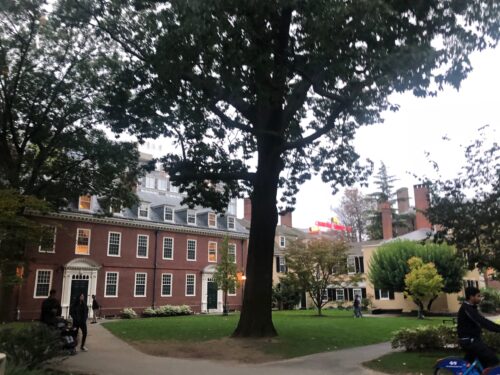This piece was originally part of a Harvard Independent themed series responding to, “How do you believe that the spirit and integrity of a Harvard College education can be best preserved in the upcoming fall semester?” Responses were collected prior to the July 6 announcement that the college would be adopting a virtual education model.
It’s tempting to imagine that it’s possible to bring 40 to 100 percent of undergraduates back to the Harvard campus in the fall and keep them safe through such measures as frequent universal diagnostic testing, housing dedensification, rigorous enforcement of social distancing rules, and remote instruction. But members of the Harvard community should be asking whether such a scenario is a) realistic or b) desirable.
Meaning, would this plan really make it possible to identify and contain cases of COVID-19 quickly enough to prevent community spread? And just as important, would the required contortions result in an educational and social experience that bears any resemblance to the Harvard we all know and love?
I believe the plans fail on both counts, and that the hard and unfortunate truth is that it will not be safe to reopen the Harvard campus to undergraduates until everyone has been vaccinated against SARS-CoV-2. To believe otherwise is magical thinking.
First off—speaking as an armchair observer of epidemiology and human behavior—I don’t think it’s safe to allow large numbers of people to come together physically unless you know you can keep R0, the number of infections that stem from a single case, below 1. A lot of government officials don’t know how to do this (or are unwilling to make citizens cooperate), and that’s why the virus is now spreading at such a frightening pace in places like Florida, Texas, and Arizona. Corporations don’t know how to do this in office spaces, and that’s part of the reason many people are continuing to work from home, even though some of the early COVID-19 restrictions on workplaces have now been eased. It’s just not plausible to expect 2,000 to 8,000 Harvard undergraduates to stay in their dorm rooms virtually continuously, wear masks every time they venture out, eschew all traditional social gatherings, and maintain the strict social distancing required to keep the virus from spreading.
Second, we should note that all of the scenarios floated for the fall semester involve some level of remote learning. I doubt you will find anyone who believes that online instruction in its current form is as effective at conveying knowledge or nurturing critical thinking as in-person instruction. And you will find no one who believes it can mimic the full college experience. It would be unconscionable to charge students anything approaching Harvard-level tuition for an experience that is so fundamentally not Harvard. Through innovation, it may eventually be possible to recreate that experience online, but right now there isn’t time to figure it out.
The inescapable conclusion is that undergraduate education at Harvard should be canceled for the duration of the pandemic—put into stasis, mothballed, whatever description you prefer.
I don’t write this happily. As chair of the alumni board of the Independent, I have a hard time imagining how the newspaper would continue to operate through such a period, or how it would be reconstituted afterward. My main point is that a college education is intrinsically a social, face-to-face experience. That’s what Harvard students are paying for, anyway. And this experience can’t be delivered under conditions of social distancing and remote learning. (I don’t say any of this to denigrate people who obtain degrees through online programs such as the University of Phoenix. They are choosing a very different experience and have different expectations of it.)
There are precedents for the stasis solution. Normal undergraduate life was effectively canceled at Harvard and most other US universities from 1942 to the end of World War II in 1945. Most upperclassmen were drafted. The Yard and most of the Houses were reserved for students receiving officer training from the Army or the Navy. Science courses replaced the liberal arts. Sports teams disbanded and extracurricular activities shut down. Summer vacations became a thing of the past. Provost Paul Buck even told students “they have no right to be in college unless they have planned their program in the light of participation in the war.”
The pandemic is an emergency on par with a world war, and could end up costing just as many American lives. Certainly, we can only beat the virus by acting together.
Marissa Garcia ’21, the editor-in-chief of the Independent and the coordinator of this opinion project, challenged contributors to say how we believe the spirit and integrity of a Harvard College education can be best preserved in the upcoming fall semester. My answer is that sadly, it cannot be. It can only be put on ice until the fall of 2021, or 2022, or whenever scientists have produced a reliable vaccine that enables everyone to come back together without having to fear being infected, or transmitting infection.
If Harvard closed for the duration, what would Harvard students do with that time? I don’t have a great answer for that, but maybe they should work, volunteer, help their families, exercise, or just spend a lot of time reading, catch up with their history textbooks. They wouldn’t be the first generation to lose a year or more of their lives to a global emergency. But they will be different, perhaps better people when this is all over. And when they come back, Harvard will inevitably be a different place, perhaps one better prepared for future disasters. That’s life on a planet where microbes make the rules.
Wade Roush ’89 formerly served as the Indy’s News Editor, Executive News Editor, and Editor-in-Chief.
Photo: Marissa Garcia ’21.
The link inserted in the final paragraph is sponsored.

